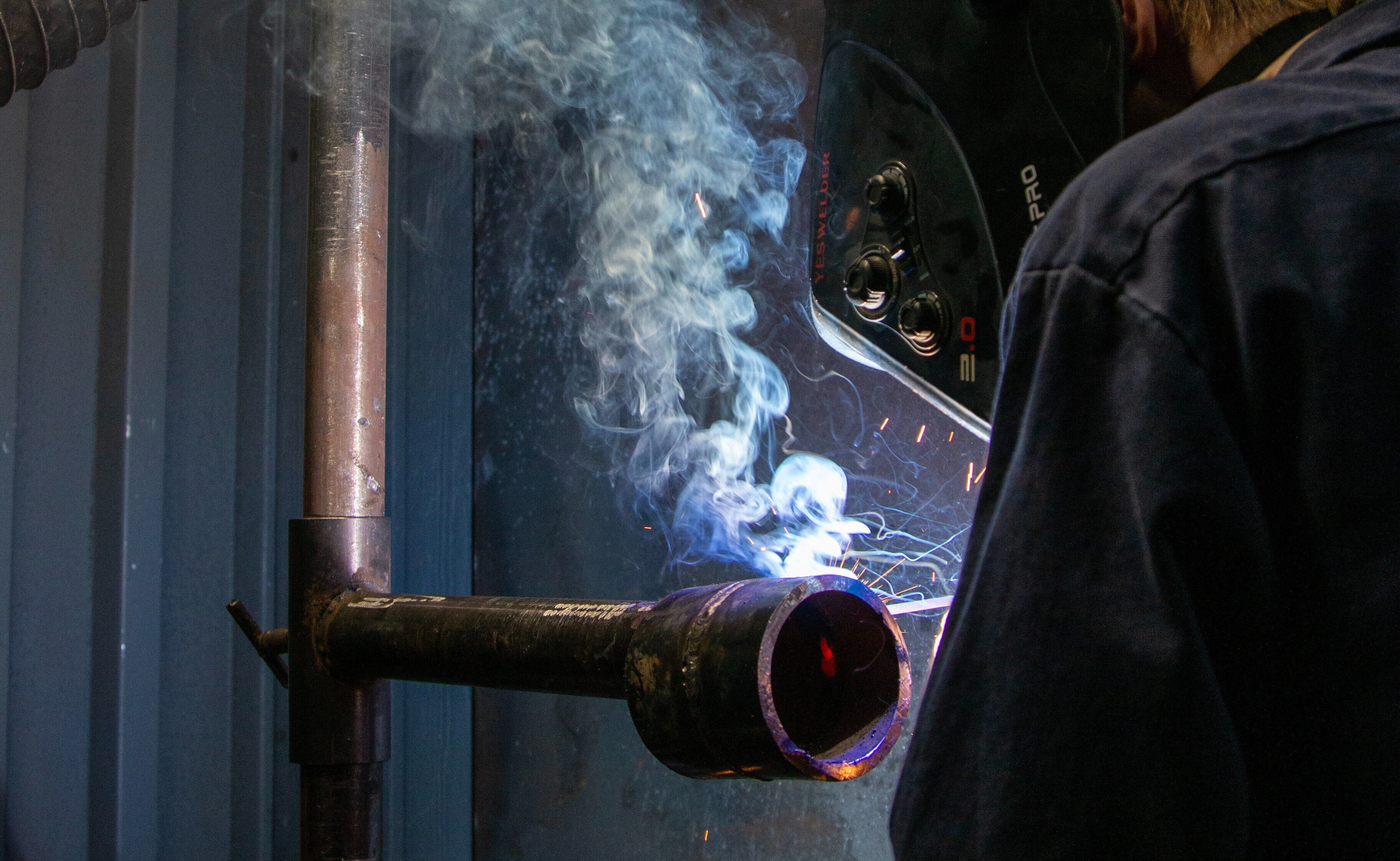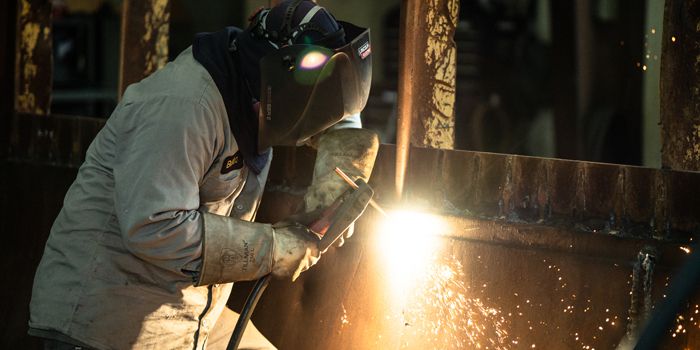All Concerning Welding: Key Insights Into Techniques and Best Practices for Success
Welding incorporates a variety of techniques, each suited for details products and applications. Recognizing these techniques, such as GMAW, SMAW, and TIG, is essential for achieving suitable results. In addition, the right devices and safety and security methods can not be overlooked. As preparation and troubleshooting play essential roles in the welding procedure, mastering these elements can significantly improve the top quality of the last item. What are the vital variables that assure an effective weld?
Comprehending Various Welding Techniques
Welding strategies include a range of methods, each suited to specific applications and materials. Among the most usual techniques are Gas Metal Arc Welding (GMAW), Secured Steel Arc Welding (SMAW), and Tungsten Inert Gas Welding (TIG) GMAW, also referred to as MIG welding, is prominent for its rate and adaptability, making it ideal for slim products. SMAW, or stick welding, is preferred for its simpleness and effectiveness in outdoor atmospheres, particularly with thicker metals. TIG welding provides accuracy and control, making it appropriate for complex job and non-ferrous steels (Montana Mobile Welding and Repair Welding). Each technique has its distinct benefits and factors to consider, allowing welders to pick the most effective method based on the task's needs, material type, and wanted outcomes. Recognizing these techniques is necessary for successful welding
Vital Welding Devices and Devices
While numerous welding methods require particular skills, the ideal equipment and tools are similarly necessary for achieving top quality results. Necessary welding devices consists of welding machines, which vary depending on the method-- such as MIG, TIG, or stick welding. Safety gear, including safety helmets, aprons, and gloves, warranties safety and security and comfort during the process. On top of that, clamps and components help protect materials in position, ensuring precision in welds. Consumables like welding poles, cord, and protecting gas are also essential parts that affect the high quality of the weld. Additionally, tools such as mills and cutters promote surface area prep work and post-weld ending up, adding to a professional result. Spending in high-quality devices inevitably enhances the performance and efficiency of welding projects.
Safety And Security Practices in Welding
Appropriate security techniques are vital in the welding industry to shield workers from prospective risks. Welders should use suitable individual safety tools (PPE), including helmets with appropriate shading, gloves, and flame-resistant clothes. Adequate ventilation is vital to minimize direct exposure to dangerous fumes and gases created throughout the welding procedure. Furthermore, workers must be learnt the appropriate handling of welding tools to stop crashes. Fire safety actions, such as keeping flammable materials away from the welding location and having fire extinguishers readily offered, are required. Regular evaluations of devices and offices can help determine prospective threats before they cause crashes. By sticking to these safety practices, welders can create a more secure working atmosphere and lessen risks connected with their profession.
Readying Products for Welding
Preparing materials for welding is a vital action that considerably influences the quality and stability of the end product (Montana Mobile Welding and Repair Belgrade). Proper prep work includes cleaning the surface areas to remove impurities such as dust, rust, and oil, which can jeopardize the weld. Methods such as grinding, fining sand, or using solvents are generally utilized to accomplish a tidy surface. Furthermore, guaranteeing that the products mesh well is crucial; spaces can bring about weak welds. It's likewise vital to think about the alignment and positioning of the elements, as this will certainly impact the ease of welding and the final result. Selecting the ideal filler material and ensuring compatibility with the base metals is crucial for achieving solid, durable welds.
Tips for Getting High-Quality Welds
Accomplishing top quality welds requires interest to information and adherence to finest techniques throughout the welding process. Correct joint prep work is necessary, ensuring surface areas are tidy and cost-free from pollutants. Picking the appropriate filler product and welding technique based on the base metals is vital for excellent bonding. Keeping consistent travel speed and angle while welding can protect against problems and advertise uniformity. In addition, controlling warmth input is necessary; too much warmth can bring about warping and compromised joints. On a regular basis evaluating the welds throughout the process allows for instant modifications if required. Ultimately, employing v welder appropriate post-weld treatments, such as cleaning and anxiety relief, can enhance the longevity and integrity of the weld, eventually making sure an effective end result.
Fixing Common Welding Issues
Welding commonly offers challenges that can impact the top quality and honesty of the end product. Common concerns such as porosity, irregular weld grains, and getting too hot can develop, each requiring particular fixing strategies. Recognizing these troubles is crucial for welders to boost their abilities and achieve excellent outcomes.
Porosity Problems Clarified
Porosity can often be forgotten, it stays an important issue in welding that can compromise the integrity of a completed item. Porosity refers to the visibility of small gas pockets within the weld grain, which can lead and compromise the joint to premature failure. This problem normally develops from impurities, wetness, or improper shielding gas protection throughout the welding procedure. To alleviate porosity, welders must confirm that the base products are clean and completely dry, utilize appropriate protecting gases, and maintain consistent welding parameters. Regularly checking the tools and environment can likewise help determine potential concerns prior to they show up in the weld. Dealing with porosity efficiently is vital for attaining strong, sturdy welds that meet quality requirements.

Inconsistent Weld Beads
Inconsistent weld grains can substantially influence the top quality and stamina of a finished product. Various aspects add to this concern, consisting of incorrect traveling rate, wrong amperage settings, and irregular electrode angles. When the welder relocates too quickly, a grain may show up narrow and lack infiltration, while relocating also gradually can create too much accumulation. Furthermore, utilizing the wrong amperage can lead to either undercutting or too much spatter, both of which concession weld stability. The welder's method, such as irregular torch motion, can likewise bring about unequal grain appearance. To minimize these problems, welders must concentrate on keeping consistent, regulated activities and making sure appropriate devices settings to achieve uniformity in their welds. Uniformity is essential to achieving trustworthy and solid welds.
Getting Too Hot and Bending Issues
Extreme warmth throughout the welding process can lead to significant getting too hot and deforming problems, affecting the structural stability of the work surface. These problems typically materialize as distortion, which can endanger placement and fit-up, making more assembly challenging. Factors adding to overheating include the selection of welding specifications, such as voltage and travel rate, along with the sort of product being bonded. To alleviate these concerns, welders must keep click here for info constant travel rate and suitable heat input while keeping an eye on the work surface temperature level. Furthermore, preheating or post-weld warmth therapy can help alleviate anxieties brought on by rapid cooling - Montana Mobile Welding and Repair Fabrication. Routine evaluation and adherence to ideal techniques are important in preventing getting too hot and making certain the long life and integrity of welded frameworks
Frequently Asked Inquiries
What Are the Profession Opportunities in the Welding Market?
The welding industry offers varied career possibilities, including positions as welders, teachers, designers, and examiners. Experts can operate in manufacturing, construction, aerospace, and vehicle industries, taking advantage of solid demand and competitive incomes in different functions.
Exactly How Can I Enhance My Welding Rate Without Giving Up Quality?
To enhance welding rate without giving up high quality, one need to exercise effective methods, maintain devices, optimize settings, and boost hand-eye control. Normal training and looking for responses can additionally greatly add to achieving quicker, premium welds.
What Certifications Are Readily Available for Welders?
Various qualifications exist for welders, including those from the American Welding Culture (AWS), the National Center for Construction Education And Learning and Research (NCCER), and different industry-specific organizations. welding group These qualifications boost employability and show ability proficiency.
Exactly How Does Welding Affect the Features of Metals?
Welding affects the residential properties of steels by modifying their microstructure, which can cause modifications in ductility, firmness, and strength. Warm input and air conditioning rates during the procedure considerably affect these product qualities.
Can I Weld Dissimilar Metals With Each Other?
